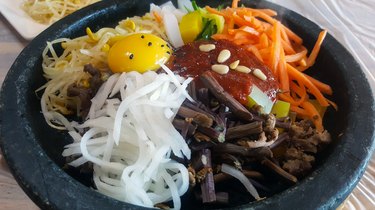
If you've never heard of bibimbap, one of the more popular Korean dishes in Western culture, it's time you tried it. With so many variations, bibimbap has a nutrition profile that you don't want to miss.
What Is Bibimbap?
Video of the Day
The Auguste Escoffier School of Culinary Arts describes bibimbap as a dish that gives a chef plenty of room for variation — which means bibimbap calories and nutritive value can vary extensively depending on how you make it.
Video of the Day
A traditional bibimbap recipe includes steamed rice with sautéed vegetables, topped with egg and sliced protein. Common vegetables include cucumber, zucchini, spinach, soybean sprouts, carrots, lettuce and mushrooms, and although thinly sliced beef is the go-to protein choice, a bibimbap recipe might instead use chicken, tofu or seafood instead.
Because of these variations, bibimbap calories will always be a little bit different as well. Bibimbap starts with a base of rice; according to the USDA, white rice has about 210 calories per half-cup serving, while brown rice has slightly less at 150 calories per half-cup.
Although the calories from vegetables will be mostly negligible, bibimbap topped with a large fried egg (about 46 grams) will have an extra 90 calories, with 6.26 grams of protein and 6.83 grams of fat, compared with a bibimbap without it.
Adding a 1-ounce portion of plain sliced beef steaks would add another 65 calories with 4 grams of protein and 5 grams of fat, and the bulgogi sauce traditionally served with it would add 60 calories with 1 gram of protein, a half-gram of fat and 14 grams of carbohydrates per 2 tablespoon serving.
But bibimbap calories aren't the only nutritional concerns you might have. Bibimbap nutrition can vary depending on the types of vegetables you use because even though they aren't adding a lot of calories, they bring lots of vitamins and minerals to the table.
If you decide to add broccoli, you would get a healthy dose of vitamins A, C, E and K, as well as calcium and chromium. Asparagus could give you a punch of folate, mushrooms have a boost of riboflavin, and seaweed will serve you some iodine.
Read more: Raw Vegetables Vs. Cooked Vegetables
Finding a Bibimbap Recipe
When you're searching for a bibimbap recipe that fits nicely into your diet, you can get creative in other ways besides what vegetables and proteins you use.
One bibimbap recipe published by the American Heart Association uses not only avocado for a serving of healthy fat but also replaces the rice with cauliflower. This version of bibimbap has 232 calories per serving, with 15 grams of fat, 20 grams of carbohydrates and 9 grams of protein.
With its mix of rice, vegetables and protein, Bibimbap could be a good choice for people who have metabolic syndrome.
According to a small study involving 32 men that was published in December 2015 in the Journal of Ethnic Foods, Korean-style meals like bibimbap have the potential to lower a person's risk of metabolic disease because they do not raise blood sugar and blood lipid levels the same way Western foods do.
Find a bibimbap recipe that fits your lifestyle or get creative with the vegetables and proteins you use to make this popular dish — you'll find it fits right in with a healthy lifestyle, and you'll never get bored with it because you can enjoy it so many different ways.
- Auguste Escoffier School of Culinary Arts: “The Best of Bibimbap”
- USDA: “White Rice”
- USDA: “Brown Rice”
- USDA: “Egg, Whole, Cooked, Fried”
- USDA: “Beef Sliced Steaks”
- USDA: “Barbecue Bulgogi Sauce”
- Food and Drug Administration: “Vitamins and Minerals”
- Journal of Ethnic Foods: “Rice-Based Korean Meals (Bibimbap and Kimbap) Have Lower Glycemic Responses and Postprandial-Triglyceride Effects Than Energy-Matched Western Meals”
- American Heart Association: “Avocado Bibimbap”